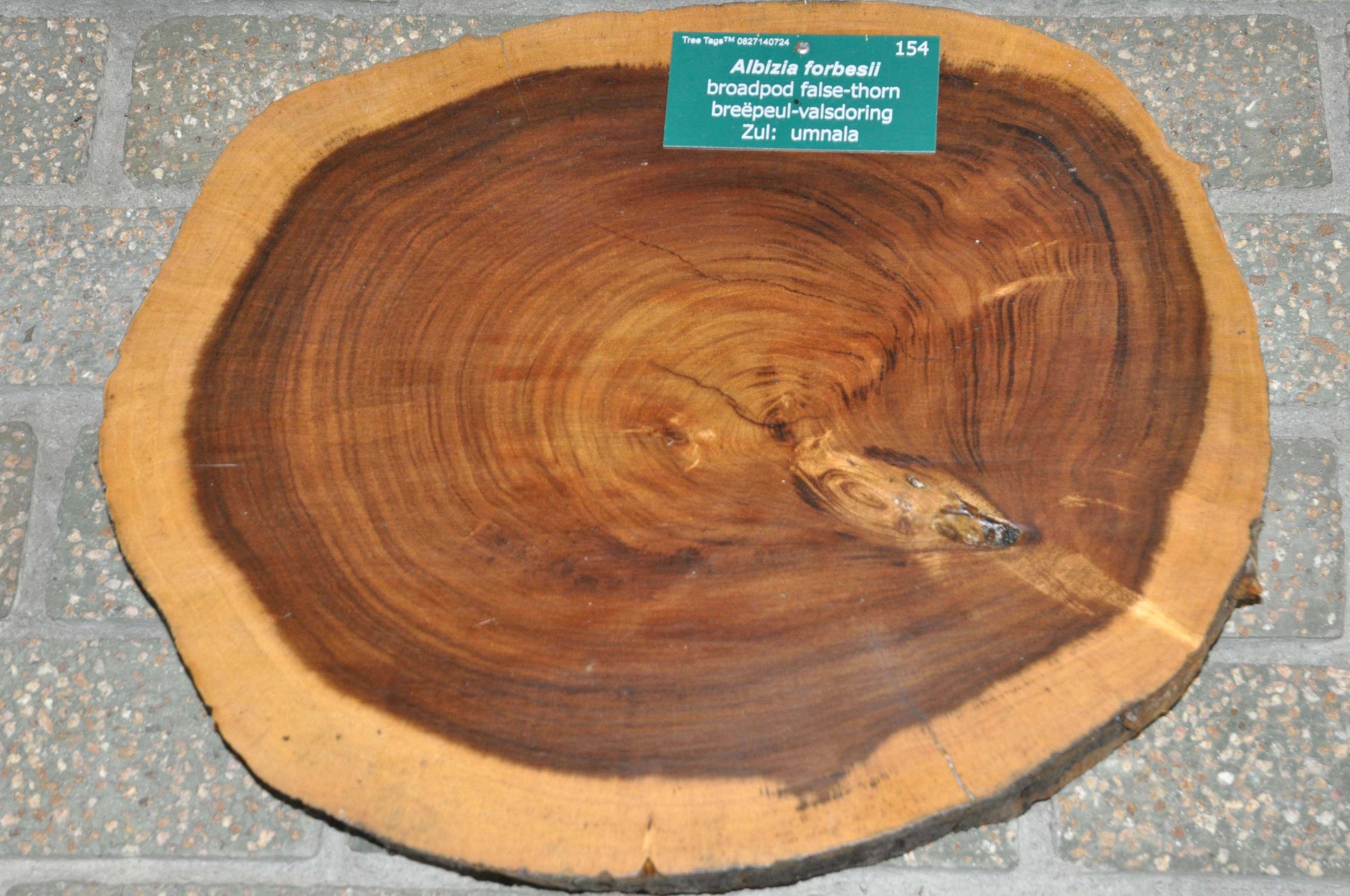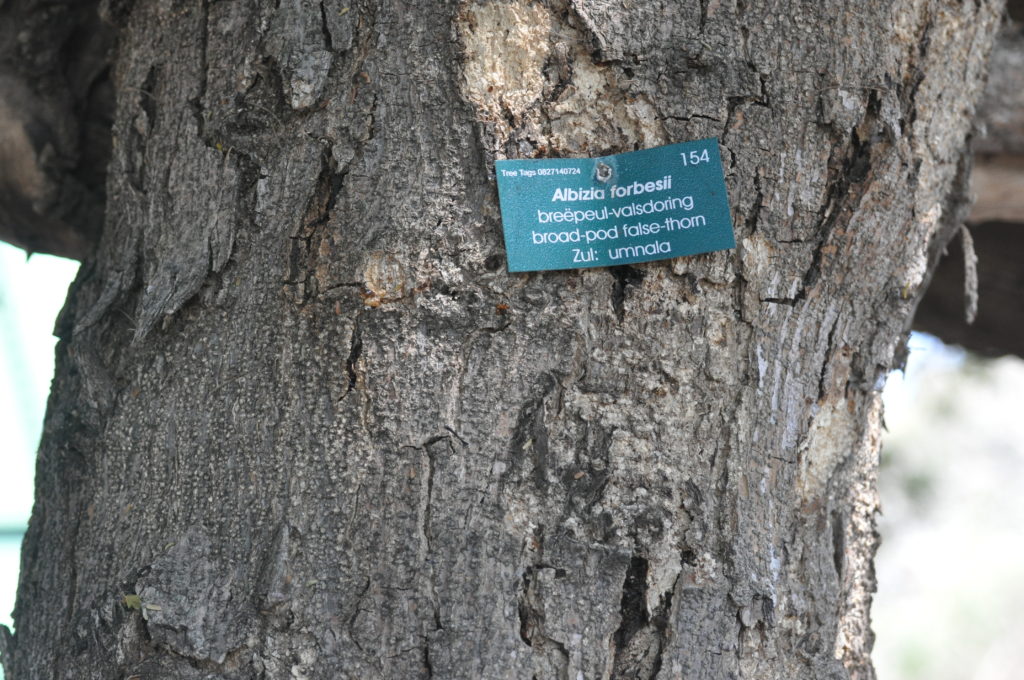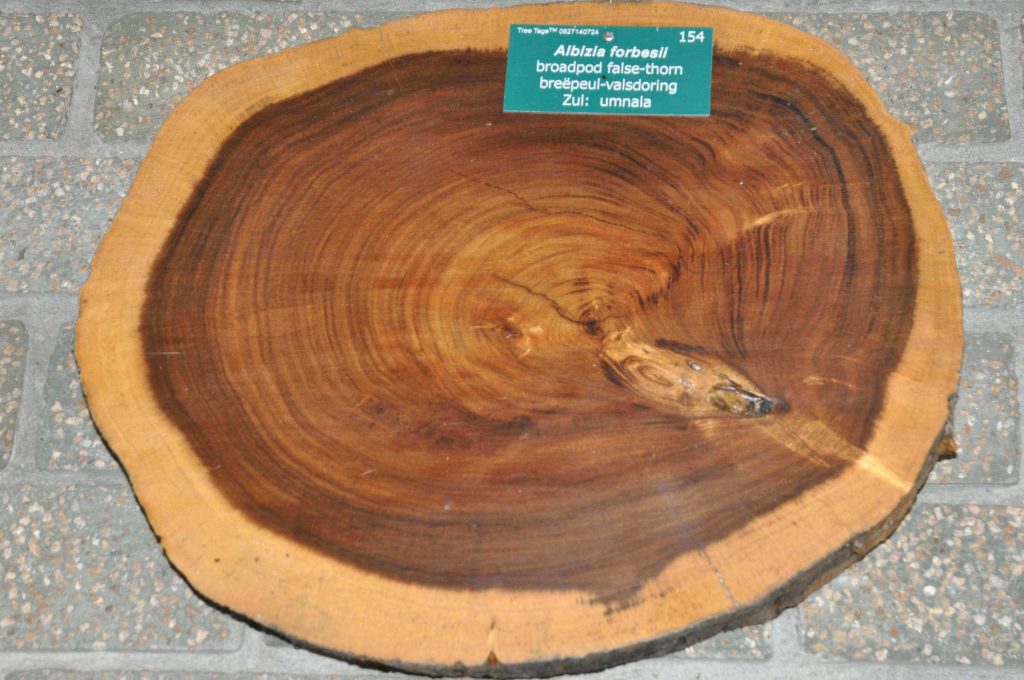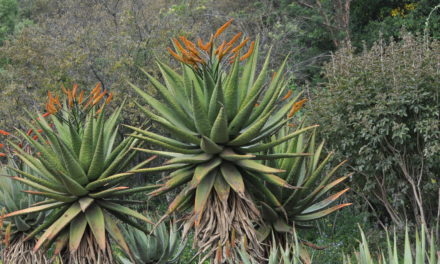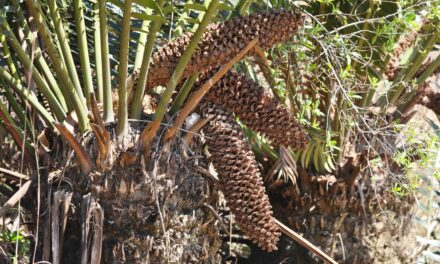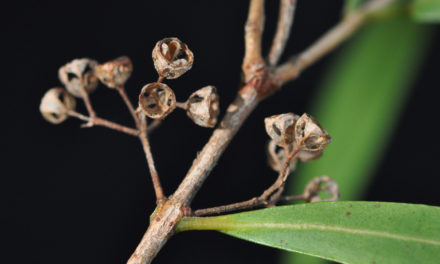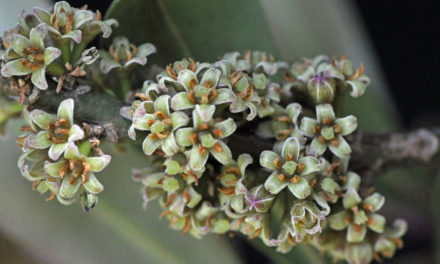General Info – summary
This unarmed Tree, with drooping young branches, is up to 20m high. Bipinnate, sparse Leaves have closely ranked leaflets. White to yellow bisexual, regular Flowers are in half-spherical heads with exerted stamens surrounding the sessile superior ovary with its belatedly extending stigma. Fruit is a large flat, straight, oblong and wide pod with no bumps over the seeds but transverse ridges are visible within pods.
Description
Albizia forbesii
Previous Names: Nil
SA Tree No. 154
Common names: (Afr) Breëpeul-valsdoring. (Eng) Broad-pod Albizia, Broad-pod false-thorn. (isiZulu) Umfomoshane, Umnala. (siSwati) umnala. (Tshivenda) Mupfumbadzi, Mutsilari. (Xitsonga) Amnala, Rinyani, Mupfumbadzi.
Family: Fabaceae, or Leguminosae (Pea, bean or legume family). After the Orchidaceae and the Asteraceae, the Fabaceae is the third largest Angiosperm (flowering plants) family with 700+ genera and close to 20 000 species. Local Tree genera on this website include Acacia (Vauchellia, Senegalia), Albizia, Bauhinia, Bolusanthus, Burkea, Calpurnia, Colophospermum, Cordyla, Cyclopia, Dichrostachys, Erythrina, Erythrophleum, Faidherbia, Indigofera, Mundulea, Peltophorum, Philenoptera, Piliostigma, Schotia and Xanthocercis. The Fabaceae are recognisable by their fruit and their pinnately compound Leaves. Leaves may also be simple – even bilobed and usually have stipules – some of which may be spinescent. Leaflets are usually entire. Flowers are bisexual and bracteate. Regular flowers usually have 4-5 sepals and the same number of petals. Irregular flowers have 4-5 sepals and 5 or less petals. Stamens have anthers that have 2 pollen sacs and there are usually at least twice the number of stamens as petals – often 10. The superior Ovary has 1 locule containing 1 or more ovules. The Stigma and Style are simple. The single carpel develops into the Fruit, which is usually a pod. The mature pods may dehisce or break into segments. Seeds vary.
Name derivation: Albizia – named after naturalist Filppo degli Albizzi (18 century) who introduced the species into Europe. forbesii after the Englishman, John Forbes, (1798-1823) who collected the type specimen in Mozambique (1822-1823). He died of malaria close to the Zambezi River. There are 11 indigenous species of the genus Albizia in southern Africa.
Conservation Status: L C. (Least Concern). Assessment: 2005 (W. Foden and L. Potter).
Tree
This unarmed (thornless) Tree has a rounded spreading crown, may reach 20m high and often has a single trunk and may have branches near the base. The smaller, hairy Branches are spreading and tend to droop. Here there are striated furrows with visible Lenticels (usually raised corky elongated areas on the plant that allow the interchange of gases with the environment). Silver-grey, velvety hairs usually occur on young growth. The light to dark grey Bark is thin and initially smoothish. With time, it thickens, becomes rough and tends to flake (photo 480).
- 480 2014.09.08 Sabi KNP. Photo: David Becking.
Leaves
This deciduous tree has Leaves that are widely spaced apart. They develop on short side branches. These compound leaves are Bipinnate – (twice pinnate). The leaf Rachis (central leaf axis) is up to 4cm long and has 2-7 pairs of lateral “branches” – pinna – not leaflets and the Pinnules (leaflets) are on these “side branches”). Each leaf is up to 8 x 4mm – excluding the hairy Petiole (leaf stalk) that is that is up to 2,8 cm long (usually less). Stipules (basal appendages of the petiole) are not spinescent and usually shed early. Leaf Pinnae have up to (6-16) pairs of asymmetric, oblong; elliptic or slightly sickle shaped, and closely packed Pinnules (leaflets). These dark green closely ranked leaflets are hairless above and turn yellow before falling. Lateral veins are slightly raised below and here scattered hairs may be present. A central gland may be present at the bases of the paired leaflets. The Apex may be rounded or slightly pointed but the single terminal pair of leaflets are obovate (egg-shaped – with the narrower end at the base). Side veins are slightly raised and visible below, and some hairs occur along the midrib. The Margins may be rolled under and are entire (with a continuous margin, not in any way indented).
Flowers
Golden, hairy buds develop into Flowers that have fluffy, half-spherical heads. The powder-puff like flowers may appear before, with or after the new leaves. Each flower rests on a Pedicle (stalk of a single flower, which may reach just over 5cm long. The base of the short-lobed Calyx is a tube. The Corolla has a funnel shaped base ending with white Petal lobes. The overall creamy white flower colour is due to the numerous long, thin Stamens each up to 1,5cm long. They are exserted (sticking out; projecting beyond) well beyond the perianth (the 2 floral envelopes considered together; a collective term for the calyx and corolla). The Anthers are peltate (shield shaped) with theca (pollen sacs) opening outwards. The superior Ovary is sessile or nearly so and contains several ovules. After pollen dispersal the filiform (thread or filament like) Style extends beyond the stamens to collect pollen. This procedure helps prevent self-pollination. (Oct-Dec).
Fruit
The reddish brown, fibrous, oblong and nearly flat Fruit is a wide, indehiscent Pod that has an oblong shape with distinctive transverse veins. It is up to 16 x 5cm. Pods may appear in impressive numbers. Externally the pods have no bumps (unlike Albizia adianthifolia indicating the positions of Seeds. Within the pods, the seeds are separated by darker transverse ridges, which become visible after seed dispersal. The open pods may hang from the tree for several months. (Feb-Aug).
Distribution & Ecology
Groups of this tree do occasionally occur. This Tree is located in Northern KwaZulu-Natal e.g., Mkuze Game Reserve, Maputaland (boarded by the Indian Ocean in the East and the volcanic Ubombo mountains (which run northwards through Eswatini and Mozambique) in the west. Trees also occur in Mpumalanga but are not generally common in Limpopo. This tree also occurs in SiSwati (Swaziland), Mozambique (south, central and northeast), Zimbabwe and Southern Tanzania. It grows best in deep sandy soil, along riverbanks and is less common in rocky areas. Trees also grow in the arid bushveld (a sub-tropical woodland ecoregion of southern Africa). Frequent bird visitors during Flowering season include Lilac-breasted roller, Glossy starlings, Bee-eaters and Fork-tailed drongos with their glossy black colour and deep red eyes. Elephant and other herbivores consume Leaves.
Ethnobotany
Uses of the Wood include building and carving. Local medicine makes use of the roots.
- 171 2018.08.13 Skukuza nursery. Photo: David Becking.
References
Boon, R. 2010. Pooley’s Trees of eastern South Africa. Flora and Fauna Publications Trust, Durban.
Burrows, J.E., Burrows, S.M., Lotter, M.C. & Schmidt, E. 2018. Trees and Shrubs Mozambique. Publishing Print Matters (Pty) Ltd. Noordhoek, Cape Town.
Coates Palgrave, M. 2002. Keith Coates Palgrave Trees of Southern Africa, edn 3. Struik, Cape Town.
Foden, W. & Potter, L. 2005. Albizia forbesii Benth. National Assessment: Red List of South African Plants version 2020.1. Accessed on 2022/12/03.
Ginn, P.J. McIlleron, W.G. Milstein, S. 1989. The Complete Book of Southern African Birds. Struik Publishers (PTY) LTD. Third impression 1991.
Lawrence, G. H. M, 1951. Taxonomy of Vascular Plants, The Macmillan Company, New York. Tenth Printing 1965.
Palmer, E. & Pitman, N. 1972. Trees of southern Africa, Balkema, Amsterdam, Cape Town.
Schmidt, S. Lotter, M. & McCleland, W. 2002. Trees and Shrubs of Mpumalanga and the Kruger National Park.
van Wyk, B. & van Wyk, P. 1997 Field guide to Trees of Southern Africa, Struik, Cape Town.
Ginn, P.J. McIlleron, W.G. Milstein, S. 1989. The Complete Book of Southern African Birds. Struik Publishers (PTY) LTD. Third impression 1991.
http://hazyviewinfo.co.za/blog/?p=656
http://www.ispotnature.org/node/591722
http://posa.sanbi.org/flora/browse.php?src=SP

